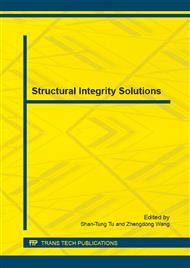[1]
O. Ranestad, Z.L. Zhang, C. Thaulow. Quantification of geometry and material mismatch constraint in steel weldments with fusion line cracks. International journal of fracture 1999; 99(4): 211-237.
DOI: 10.1016/s0013-7944(99)00087-9
Google Scholar
[2]
G.R. Irwin, J.A. Kies, H.L. Smith. Fracture strengths relative to onset and arrest of crack propagation. Proceedings of the ASTM 1958; 58: 640–660.
Google Scholar
[3]
S.J. Garwood. Effect of specimen geometry on crack growth resistance. In: Fracture mechanics. ASTM STP 677. American Society for Testing and Materials. 1979. p.11–532.
Google Scholar
[4]
J. Yang, G.Z. Wang, F.Z. Xuan, S.T. Tu. An experimental investigation of in-plane constraint effect on local fracture resistance of a dissimilar metal welded joint. Materials & Design 2014; 53: 611-619.
DOI: 10.1016/j.matdes.2013.07.058
Google Scholar
[5]
J. Yang, G.Z. Wang, F.Z. Xuan, S.T. Tu. Out-of-plane constraint effect on local fracture resistance of a dissimilar metal welded joint. Materials & Design 2014; 55: 542-550.
DOI: 10.1016/j.matdes.2013.10.034
Google Scholar
[6]
E. Ostby, Z.L. Zhang, C. Thaulow. Constraint effect on the near tip stress fields due to difference in plastic work hardening for bi-material interface cracks in small scale yielding. International journal of fracture 2001; 111(1): 87-103.
Google Scholar
[7]
C. Ruggieri, F. Minami, M. Toyoda. Effect of strength mis-match on crack tip stress fields of HAZ-notched joints subject to bending and tension. Journal of the Society of Naval Architects of Japan 1993; 174: 543–549.
DOI: 10.2534/jjasnaoe1968.1993.174_543
Google Scholar
[8]
G. Lin, X.G. Meng, A. Cornec, K.H. Schwalbe. The effect of strength mis-match on mechanical performance of weld joints. International journal of fracture 1999; 96(1): 37-54.
Google Scholar
[9]
H.T. Wang, G.Z. Wang, F.Z. Xuan, S.T. Tu. Numerical investigation of ductile crack growth behavior in a dissimilar metal welded joint. Nuclear Engineering and Design 2011; 241(8): 3234-3243.
DOI: 10.1016/j.nucengdes.2011.05.010
Google Scholar
[10]
H.T. Wang, G.Z. Wang, F.Z. Xuan, S.T. Tu. An experimental investigation of local fracture resistance and crack growth paths in a dissimilar metal welded joint. Materials & Design 2013; 44: 179-189.
DOI: 10.1016/j.matdes.2012.07.067
Google Scholar
[11]
V. Tvergaard. On localization in ductile materials containing spherical voids. International Journal of Fracture 1982; 18: 157-169.
DOI: 10.1007/bf00015686
Google Scholar
[12]
V. Tvergaard, A. Needleman. Anlysis of the cup-cone fracture in a round tensile bar. Acta Metallurgica 1984; 32: 157-169.
DOI: 10.1016/0001-6160(84)90213-x
Google Scholar
[13]
N. Benseddiq, A. Imad. A ductile fracture analysis using a local damage model. International Journal of Pressure Vessels and Piping 2008; 85: 219-227.
DOI: 10.1016/j.ijpvp.2007.09.003
Google Scholar
[14]
S.B. Liu. Study on the local ductile damage and fracture behavior in dissimilar metal welded joint in nuclear power plants. Shanghai: East China University of Science and Technology, (2013).
Google Scholar
[15]
E. Ostby, C. Thaulow, Z.L. Zhang. Numerical simulation of specimen size and mismatch effects in ductile crack growth-Part I: tearing resistance and crack growth paths. Engineering Fracture Mechanics 2007; 74: 1771-1791.
DOI: 10.1016/j.engfracmech.2006.09.013
Google Scholar
[16]
J. Gurland, J. Plateau. Trans ASM 56 (1963) 443-454.
Google Scholar
[17]
J.R. Low. Investigation of the Plastic Fracture of Aluminum Alloys and High Strength Steels, Carnegie-Mellon University, (1998).
Google Scholar


